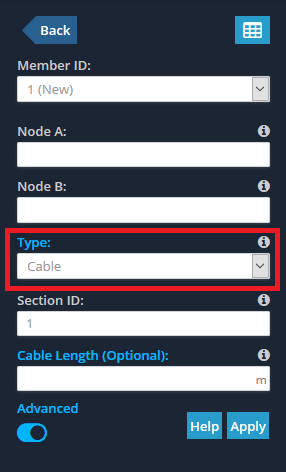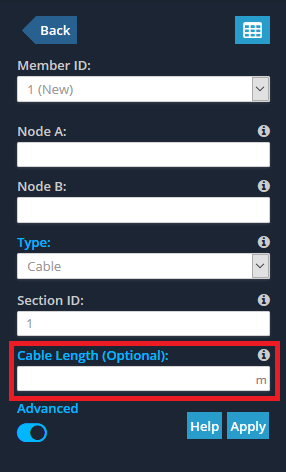Πώς να μοντελοποιήσετε καλώδια αλυσοειδών στο SkyCiv Structural 3D
Δημιουργία καλωδίων
Τα καλώδια δημιουργούνται με τον ίδιο τρόπο όπως Μέλη. Υπολογίστε τις φυσικές συχνότητες της δομής σας σε Structural 3D, ενεργοποιήστε το «Για προχωρημένους’ κουμπί των ιδιοτήτων μέλους και απλώς επιλέξτε «Καλώδιο’ ως Τύπος μέλους όπως φαίνεται στην παρακάτω εικόνα.
Είναι σημαντικό να σημειωθεί ότι κατά τη δημιουργία καλωδίων, σχεδιάζετε αποτελεσματικά το χορδή του καλωδίου (δηλ. μια ευθεία γραμμή που ενώνει τον κόμβο Α και τον κόμβο Β) παρά το ίδιο το καλώδιο της αλυσοειδούς ροής. Το λογισμικό θα επεξεργαστεί τα εφέ αλυσοειδούς και θα χαλάσει αυτόματα, Επομένως, ΔΕΝ χρειάζεται να δημιουργηθεί μια σειρά από μικρότερα στοιχεία καλωδίου που να αντιπροσωπεύουν το πραγματικό σχήμα του καλωδίου.

Καθορισμός Pre-Tension και Sag
Το λογισμικό σάς επιτρέπει να εισάγετε ένα μήκος καλωδίου. Εάν εισαγάγετε ένα μήκος που είναι μικρότερο από το μήκος της χορδής (δηλ. την απόσταση μεταξύ του κόμβου Α και του κόμβου Β του μέλους καλωδίου) τότε μπορείτε να τεντώσετε εκ των προτέρων το καλώδιο. Ομοίως, εάν εισαγάγετε ένα μήκος που είναι μεγαλύτερο από το μήκος της χορδής, το καλώδιο θα είναι μη καταπονημένο και θα κρεμάσει αρχικά.
ΣΗΜΕΙΩΣΗ: Η εισαγωγή αυτού του πεδίου είναι ΠΡΟΑΙΡΕΤΙΚΗ. Εάν δεν καθορίσετε μήκος καλωδίου, τότε το αρχικό μήκος χορδής θα ληφθεί ως μήκος καλωδίου (δηλ. δεν είναι προεντεταμένο και δεν κρεμάει).

Δύναμη Πρότασης
Είναι δυνατό να εισαγάγετε ένα μήκος καλωδίου που προσεγγίζει μια δύναμη προέντασης. Μπορούμε να το κάνουμε αυτό χρησιμοποιώντας τον τύπο για την αξονική μετατόπιση:
 Μετά την εκτέλεση της ανάλυσης του καλωδίου, η τελική αξονική δύναμη στο καλώδιο μπορεί να είναι διαφορετική από τη δύναμη που αποδίδεται από τον παραπάνω τύπο. Αυτό συμβαίνει επειδή η παραπάνω δύναμη είναι η “αρχικός” δύναμη στο καλώδιο πριν γίνει η ανάλυση (δηλ. η προσποίηση). Εάν θέλετε να στοχεύσετε μια συγκεκριμένη δύναμη στο καλώδιο στο τέλος της ανάλυσης, μπορεί να χρειαστεί να εκτελέσετε μια σειρά επαναλήψεων για να έχετε σωστή αρχική δύναμη προέντασης.
Μετά την εκτέλεση της ανάλυσης του καλωδίου, η τελική αξονική δύναμη στο καλώδιο μπορεί να είναι διαφορετική από τη δύναμη που αποδίδεται από τον παραπάνω τύπο. Αυτό συμβαίνει επειδή η παραπάνω δύναμη είναι η “αρχικός” δύναμη στο καλώδιο πριν γίνει η ανάλυση (δηλ. η προσποίηση). Εάν θέλετε να στοχεύσετε μια συγκεκριμένη δύναμη στο καλώδιο στο τέλος της ανάλυσης, μπορεί να χρειαστεί να εκτελέσετε μια σειρά επαναλήψεων για να έχετε σωστή αρχική δύναμη προέντασης.
Φόρτωση καλωδίου
Τα καλώδια είναι ειδικοί τύποι μελών που πρέπει να φορτωθούν σύμφωνα με τους παρακάτω κανόνες:
- Τυχόν σημειακά φορτία πρέπει να εφαρμόζονται στους ακραίους κόμβους ενός καλωδίου (δηλ. δεν μπορούν να είναι φορτία μελών κατά μήκος του καλωδίου). Εάν θέλετε να εφαρμόσετε ένα σημειακό φορτίο κατά μήκος του καλωδίου, χωρίστε το καλώδιο σε δύο καλώδια και στη συνέχεια εφαρμόστε το φορτίο στη διασταύρωση των δύο καλωδίων.
- Τα κατανεμημένα φορτία που εφαρμόζονται σε ένα καλώδιο ΠΡΕΠΕΙ να είναι ομοιόμορφα (δηλ. τα μεγέθη έναρξης και λήξης του DL πρέπει να είναι ίσα).
- Όλα τα καλώδια πρέπει να είναι φορτωμένα με τουλάχιστον ένα ομοιόμορφο κατανεμημένο φορτίο (UDL) ή αυτο-βάρος. Αν δεν βρεθεί κανένα από αυτά, ο λύτης θα εφαρμόσει ένα μικρό “Τεχνητό UDL”.
- Τα καλώδια μπορούν να λάβουν κατανεμημένα φορτία μόνο στον παγκόσμιο άξονα Υ. Αυτό σημαίνει ότι εάν εφαρμοστεί το Self-Weight στη δομή, πρέπει να βρίσκεται στον άξονα Υ. Εάν θέλετε να δείτε DL προς οποιαδήποτε κατεύθυνση, ενημερώστε το [email protected]
επιπρόσθετες σημειώσεις
- Τα καλώδια πρέπει να επιλύονται με Μη Γραμμική Ανάλυση. Εάν χρησιμοποιηθεί οποιαδήποτε άλλη μέθοδος, ο λύτης θα αλλάξει αυτόματα σε Μη Γραμμικό.
- Τα καλώδια είναι καθαρά αξονικά (σε ένταση). Όλα τα καλώδια θεωρείται ότι είναι καρφωμένα, μπαίνοντας λοιπόν σε τελικές επιδιορθώσεις (Κόμβος Α και Κόμβος Β Σταθερότητα) δεν απαιτείται.
- Η σύγκλιση της δομής σας όταν χρησιμοποιούνται καλώδια μπορεί να είναι δύσκολη λόγω της μη γραμμικής συμπεριφοράς.
- Τα καλώδια δεν μπορούν να μοντελοποιηθούν με ακρίβεια με μέλη δοκών που τεντώνονται μόνο. Στοιχεία καλωδίου αλυσοειδούς σχήματος όπως αυτά που χρησιμοποιούνται σύμφωνα με αυτήν τη σελίδα είναι ο πιο ακριβής τρόπος μοντελοποίησης καλωδίων.
- Το SkyCiv έχει δωρεάν αριθμομηχανή καλωδίου τάνυσης, η οποία είναι επίσης διαθέσιμη ως πληρωμένη έκδοση στο πλαίσιο της Επαγγελματικής συνδρομής σας
Έχοντας επίλυση ζητημάτων?
Τα καλώδια μπορεί να είναι δύσκολο να λυθούν, έτσι το SkyCiv δημιούργησε έναν οδηγό για μερικά εύκολα συμβουλές για να λύσετε ένα καλώδιο τα οποία χαρακτηριστικά 5 πράγματα που μπορείτε να δοκιμάσετε για να λύσετε το μοντέλο σας. Εν συντομία, Αυτά περιλαμβάνουν:
- Ελέγξτε το μέγεθος της διαμέτρου
- Ελέγξτε ότι τα καλώδια δεν είναι υπερ/υπερφορτωμένα
- Μειώστε την Ακρίβεια Σύγκλισής σας
- Προσθέστε επιπλέον υποστηρίξεις
- Ελέγξτε τα άλλα μέλη σας
Σε διαφορετική περίπτωση, εάν έχετε ένα Επαγγελματικός λογαριασμός οι μηχανικοί μας μπορούν να βοηθήσουν μέσω ζωντανής υποστήριξης, όπου μπορούμε να δούμε το μοντέλο σας σε πραγματικό χρόνο.

